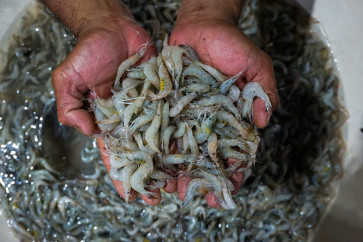Popular Reads
Top Results
Can't find what you're looking for?
View all search resultsPopular Reads
Top Results
Can't find what you're looking for?
View all search resultsExorcising for a happy home in Ketapang
At work: Yulianus swings a black chicken back and forth, reciting mantras
Change text size
Gift Premium Articles
to Anyone
A
span class="caption" style="width: 510px;">At work: Yulianus swings a black chicken back and forth, reciting mantras.--Markus MardiusIt began in the family room of the house with two shamans sitting cross-legged facing their host.
The men, Deomedes Duli and Yulianus Sarneon, gulped two cups of arak, a local spirit, to start the Nyimak Rumah, a Dayak ritual for preparing a new house for occupancy.
While chewing on betel, Deomedes swung a black chicken back and forth, reciting mantras in response to Yulianus.
He then plucked the chicken's feathers, strewing them over the heads of the host and other members of the family before sprinkling yellow rice mixed with fried rice to the left and right to symbolize the exorcism of evil spirits from the house.
According to members of the Dayak Simpakng community, which comprises about 300 households in Karab village in Ketapang, West Kalimantan, the Nyimak Rumah is mandatory for those who are going to occupy new homes.
Soon after, Yulianus walked outside, where a gamelan and drums were waiting. Behind him was Matheus Sugeng, the family head hosting the ceremony.
Drinking a cup of arak, Yulianus began to swing another black chicken. He also plucked its feathers and strewed them out along with yellow and fried rice. The gamelan and drums were then showered with feathers and rice to rid them of evil spirits.
Good vibrations: Nyimak Rumah rituals typically last for a whole day and night ' sometimes even longer.--Markus Mardius
The cleansed instruments were then be played all night long by several skilled relatives and guests.
As Deomedes and Yulianus finished, their pabayu, or assistants, were preparing offerings to be placed in two square woven bamboo containers called ancak. The sacrifices were meant to be consumed by the malevolent spirits so as to prevent them from disturbing the host and family while residing in the new house.
The ancak contained several leaves anointed with water treated with mantras to fight evil, cooked chicken livers and beef, chicken claws and meat, pig livers and pork, pelomak (sticky rice steamed in bamboo tubes), a traditional kris dagger, a blunt axe, incense, betel leaves, lime, areca nuts, tobacco and several palm-leaf cigarettes.
This time, Deomedes led the ritual, presenting the offerings with mantras. Wielding the leaves and holy water, he orbited the offerings, sprinkling the ancak with the drenched leaves.
Then the assistants accompanied Deomedes, carrying the ancak to the second floor, where they were hung facing the west and east to drive evil spirits away after they had enjoyed the sacrifices.
Nyimak Rumah rituals typically last for a whole day and night ' sometimes even longer. The ritual also expresses gratitude to God for having saved the family head from various obstacles in the process of building the house so that it can be completed without incident and prepared for the family who will call it home.
According one local community leader, the Dayak Simpakng people performed the ritual for generations before the arrival of Catholic missionaries to the region in the 1940s.
'This ritual must never be just skipped, although there's some disagreement with the teachings of the church,' Adrianus Singsang, demong (communal chief) of the village, said. 'The Dayak Simpakng are indeed Roman Catholics, but the traditional ceremony has never been forgotten.'
He continues, 'There will be grave consequences if a new house is occupied right away without a traditional ritual. It's believed that the family head will face misfortunes if the time-honored practice is disregarded. Besides, communal sanctions will certainly be imposed by the local demong.'
Among the mishaps that might befall the people who live in a house that has not been exorcised are serious diseases, disharmony and conflict, hostile neighbors and crop failures, according to Adrianus.
'It's obligatory for every family moving to a new house to observe the ritual. Even before building a house, the owner is required to invite shamans in order to rid the construction site of evil spirits, which can disturb the building process,' he added.
Matheus said that the Nyimak Rumah took some preparation. 'The ritual in fact demanded a fairly big sum and various thorough preparations that took at least three months to complete.'
The shamans had to determine an appropriate day and month for the ritual, for example, Matheus said. He also had to distill the arak, raise the sacrificial pigs and chickens in addition to a host of activities.
While much has been written about Dayak rituals, the local administration has not prioritized preserving the Nyimak Rumah ceremony.
Yulianus, however, says he is proud because the tradition has been perpetuated by people today. Every time the Nyimak Rumah is observed, it always draws the attention of villagers, who readily take part in the ceremony, he says.
'People are very fond of joining this ritual because they can see their relatives from far-off areas,' Yulianus said. 'This event is not just attended by local villagers but also visited by many of their family members or relatives living in other villages.'











